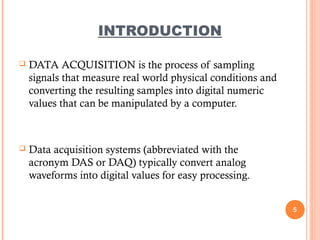Unlocking Insights: The Power of Modern Data Acquisition Systems
Unlocking Insights: The Power of Modern Data Acquisition Systems
Blog Article

In today's data-driven world, the ability to capture and analyze information in real-time is more crucial than ever. Modern data acquisition systems are at the forefront of this transformation, enabling organizations to gather valuable insights from a myriad of sources. From industrial applications to environmental monitoring and beyond, these systems play a vital role in helping decision-makers understand complex datasets and make informed choices.
As technology continues to evolve, so do the capabilities of data acquisition systems. With advancements in sensors, processing power, and connectivity, these systems have become more sophisticated and accessible. They not only streamline the collection of data but also enhance the accuracy and speed of analysis, allowing businesses to unlock hidden patterns and trends. The resulting insights can drive innovation, improve operational efficiency, and ultimately lead to better outcomes across various fields.
Understanding Data Acquisition Systems
Data Acquisition Systems are integral tools for collecting, measuring, and analyzing data from various sources. They are used across many industries, including healthcare, manufacturing, and environmental monitoring. These systems automate the process of gathering data, which reduces the chances of human error and enhances the accuracy and reliability of the information collected. By transforming raw data into usable information, they provide valuable insights that facilitate informed decision-making.
At the core of a Data Acquisition System are sensors and instruments that detect physical phenomena such as temperature, pressure, and light. These sensors convert analog signals into digital data, which can be processed and analyzed. Data Acquisition Systems can be configured to sample data at specific intervals, allowing for real-time monitoring or batch data collection, catering to the specific needs of the user. The flexibility in configuration is one of the key benefits of these systems.
The integration of software and hardware elements in Data Acquisition Systems allows for sophisticated data analysis and visualization. Users can set thresholds, generate alerts, and create reports based on the collected data. This capability is essential for industries that rely on continuous monitoring to ensure safety, efficiency, and compliance with regulations. As technology advances, Data Acquisition Systems continue to evolve, incorporating features such as wireless connectivity and cloud storage, further enhancing their functionality and accessibility.
Key Components and Technologies
A Data Acquisition System relies on several core components that work together to collect, store, and analyze data. Essential elements include sensors and transducers, which convert physical phenomena into electrical signals. These elements play a crucial role in gathering information from various sources, such as temperature, pressure, and motion. Each type of sensor is designed for specific applications, ensuring accuracy and reliability in data collection.
Signal conditioning is another critical technology in Data Acquisition Systems. Once the data is gathered by sensors, it often requires processing to ensure that the signals are in a suitable format for analysis. This includes amplification, filtering, and analog-to-digital conversion. Signal conditioning enhances the quality of the data being collected, transforming raw information into a form that can be easily interpreted and utilized by software applications.
The integration of software plays a significant role in modern Data Acquisition Systems. Advanced software tools facilitate real-time data visualization, analysis, and reporting. These applications allow users to monitor the health of systems, identify trends, and perform predictive analytics. With the rise of cloud computing and IoT, data acquisition is becoming increasingly accessible, enabling organizations to harness insights from their data efficiently and effectively.
Data Acquisition System
Applications and Impact on Industries
Data Acquisition Systems have become integral to various industries, enabling real-time monitoring and data analysis that drive operational efficiency. In manufacturing, these systems enhance productivity by capturing data from machines and processes, allowing for predictive maintenance, quality control, and streamlined production workflows. As a result, companies can reduce downtime and optimize their resources, leading to significant cost savings.
In the healthcare sector, Data Acquisition Systems play a crucial role in clinical research and patient monitoring. They facilitate the collection of vital signs and other medical data, which can be analyzed to improve patient care and clinical decision-making. This real-time data collection enables healthcare professionals to respond quickly to patient needs, ultimately enhancing treatment outcomes and operational effectiveness in medical facilities.
The environmental sector also benefits greatly from Data Acquisition Systems, which are used to monitor air and water quality, track wildlife populations, and manage natural resources. By gathering data on environmental conditions and trends, these systems help organizations make informed decisions regarding conservation efforts and regulatory compliance. Consequently, they contribute to sustainable practices and the preservation of ecosystems, demonstrating the broad impact of data acquisition on promoting environmental health.
Report this page